In this blog post, you’re going to brainstorm how to build your email list. You’ll also learn how to promote anything you want simply by giving away 100% free email courses.
You might be wondering, what’s an email course?
An email course is simply an autoresponder series designed to educate and entertain your audience. You can also sprinkle the content with your sales messages.
If you have no idea what you could give away to your prospects to build an email list, then you’re going to love this guide.
What Exactly Is An Email Course?
An email course is a cool way to teach your ideal prospects. You can teach them anything you want. The online learning industry is massive and keeps getting bigger. According to this article on Forbes, the eLearning industry is a multi-hundred-billion-dollar per year industry.
The beauty of an email course is that they’re remarkably versatile. Just about any small business could launch an excellent email course if it puts in a little effort.
- A dentist could teach how to keep your teeth white
- A marketing consultant could explain how to generate leads
- A real estate agent could show how to sell your house in 30 days
- An affiliate marketer could teach how to use their affiliate products of choice properly
- A bakery could explain how to make the perfect blueberry scones
- A graphic designer could teach how to design beautiful logos
- A freelance writer could teach how to write excellent blog posts
Your email course can be as long or as short as you want. It depends upon how in-depth you wish to go in your course lectures.
Your course could be for three days, seven days, 21 days, or even 30 days.
For the remainder of this guide, let’s pretend that you decide that a 7-day email course is the best for your situation.
The 7 Unbelievable Benefits To Having A 7-Day Email Course (Or Several)
There are seven main benefits to creating your 7-day email course and using it to generate sales and to build your email list simultaneously.
Benefit # 1 – Email Courses Help To Generate Targeted Leads
You can use the 7-day email course to build your list. If you’re frustrated because your email list is dismally small, then you’re going to make an asset that can help.
Benefit # 2 – Email Courses Allow You To Promote Anything You Want
Email courses are an excellent opportunity to include a call to action. If you launch classes, are an affiliate marketer or have anything to sell, then email courses are a great way to get the word out. You’re also helping people at the same time, so it’s a win/win!
So email courses are perfect for affiliate marketers, vendors, teachers, freelancers, network marketers, blog owners, and of course, authors.
Benefit # 3 – Email Courses Provide Massive Good Karma
The best part about the 7-day email course is that you can generate massive good karma and authority by gifting them to your prospects. Your students will appreciate the content that you give to them, as long as the content rocks.
That’s because your content is going to help people and contribute to their lives. Ideally, your email course is building your business, your email list, and, hopefully, your revenue all at the same time.
Benefit # 4 – Email Courses Are Evergreen
An email course is also totally evergreen and scalable. You can write as many email courses as you want, for as many audiences as you want. You can even make the course longer or shorter if you wish.
Benefit # 5 – Email Courses Are Super Easy to Launch and Deploy
An email course is so easy to make. You could sit down and have an excellent brainstorm session about what problems your audience is having. Then write seven or so pages describing the frustrations that your audience has and then draft solutions.
So you’re going to be generating massive good karma and authority by using this type of lead magnet because it can help your prospects tremendously.
Benefit # 6 – Email Courses Make Perfect Lead Magnets
Let me ask you this. How many reports (or books) do you have that you’ve never read? I know I have dozens, if not hundreds. So, PDF-documents are just kind of boring; there’s no real soul to them. There’s a good chance that your audience will never even read them. But, with an email course, you can tell how many people are reading your class because you get the statistics from your email autoresponder. So you can measure what they like to read, and what they don’t like.
Benefit # 7 – Email Courses Are Super Scalable
You can create as many email courses as you want. So imagine if you have five, ten, or twenty different email courses. Your email courses may boast slightly different teaching angles so you can attract different audiences. You could then attract different people, who might wish to try slightly different things.
That’s another hidden benefit. Email courses only invite the people you want. They make for very targeted lead magnets.
Email courses are also very quick, lean, and easy to make. You could create a beautiful lead magnet in the form of a 7-day email course in a few hours, as opposed to taking months or a year writing a book to give away instead.
So, these are just the primary and apparent benefits of creating a 7-day email course. I’m confident that over time, as you brainstorm more course ideas using the methods, we’re about to discuss. You’ll be able to think of dozens of benefits and exciting ways you can create these for your audience.
How To Easily Write An Awesome Email Course One Lecture At A Time
First, let’s talk about email copywriting.
Writing email courses is the most natural thing in the world. The mentality to have when you’re writing is just the same as when you’re writing your best friend.
Never get flustered when writing, and pretend that your best friend is on your email list. Pretend that everything you teach; you’re showing your best friend. This way, you’re going to be yourself, you’ll never get flustered, get scared, or become a nervous wreck.
Additionally, it’s the best litmus test because your content is never going to suck. Because you’d never send your best friend bad advice, right?
So, you vow to promise that you’re not going to let perfectionism squander your efforts.
Because if you’re frustrated and scared that your content isn’t perfect, then you’re never going to write your 7-day course. Procrastination isn’t rocket science. Just start writing! It’s enjoyable, easy, and fast to do, as long as you don’t over-analyze everything.
I’m also going to show you later on in this course why perfectionism is redundant when you create a 7-day email course. You’ll agree with me fully as you take the following lectures.
For now, remember that it’s cool if you’re not perfect. Because your subscribers are never going to be accurate, and they want to know the real you.
With that said, I’ll see you in the next lecture and never stand in your way, because this is a lot of fun.
How To Easily Outline Your Email Course
Writing a 30-day email course is a lot of work! That’s one reason why having a tiny 3-day email course or a 7-day email course might be a better idea.
Because it’s so easy to write seven impressive pieces of content, you could easily do that in just a few sittings if you wanted to.
And then, if nobody ever enrolls in your course, you’re not at much of a loss. You haven’t lost anything.
Meaning, try your best to make it so your course content will last forever. That way, you can throw it on your blog if you want to. You can repurpose that content several ways you can create videos with it; you could even create a video course with that content if you want to.
But, I’m getting off on a tangent, the point is, creating the 7-day course is supposed to be fun to create, and fun for your end-users to read.
So, how do you outline your email course? What content should your email course include?
Well, my advice is to spend time brainstorming what content your ideal prospects want to learn. Also, try to include some of your best content.
Don’t skimp out on your email course, because the better your course content is, the more impressed your subscribers are going to be. If you write fantastic content, then you’ll get more good karma and prestige, and you’ll be able to help more people.
And, you’ll also be able to advertise anything you want throughout your course by merely having a PS at the end of each email. You can use that PS to invite your end-users to check out whatever you want. So you could promote your business, your latest promotion, or even an affiliate offer.
So here’s my advice. You know your audience better than I do. You know your prospective students, probably more than they know themselves.
For that reason, you know what you should teach in your 7-day course.
What are the seven most prominent and most important lessons that you can teach in your niche? Or, for whatever sub-niche you’re referencing?
More important than the actual content itself, is that your content is high quality. If your content sucks, then your subscribers are probably going to unsubscribe. Make sure the content helps people. Try your best to give away your best material. You can put your best foot forward, while at the same time generating a massive affinity with your audience.
Later on in this guide, I’ll talk more about how to structure your content, and how to start brainstorming from scratch. For now, remember always to bend over backward to ensure that your audience has a perfect time reading your content. Make the experience of your students awesome!
Writing Your Email Course In Much Less Time Than You Think
You might be thinking, “Mike there’s no way I’m going to give away my best content for free.”
But in this case, it’s essential to give away your best content for free.
Because the more impressed your prospects are with your content, the more likely they’re going to read your future emails. If you write fantastic content, then your subscribers might even check out products that you recommend.
So, try to create excellent content. Maybe on email one, you introduce yourself, emails two through five teach fantastic content, and your seventh email is a hard pitch.
There are nearly infinite ways you can structure your courses. I encourage you to exercise full freedom and confidence, knowing that there’s no perfect way to do it. I’ve written tons of email autoresponder campaigns over the years, and they’re all different. Try not to worry about perfectionism.
Turn Your Existing Content Into An Awesome Email Course!
If you have existing blog content, then you can easily reuse that. Or, you can create the content from scratch.
Creating the actual course content is a breeze. The real emails can be as long or as short as you want. That said, here’s my advice.
Keep your email content as short as you can make it, while at the same time offering as much value as possible.
The reason for that is because people have very little spare time these days, especially in the United States. A lack of time results in people having less of an attention span, less energy, and by and large less time to read long in-depth emails.
So, do them a favor and work on keeping your content concise and brief.
Don’t tell your students how to build a watch. Just tell them what time it is.
The good news is that you can open Microsoft Word, create seven different topics of your mini-lessons in one sitting if you want.
Why Your Email Course Doesn’t Need To Be Perfect
You might be thinking that there’s no way you can create seven mini-lessons in one sitting. Remember that perfectionism is an unpleasant condition, and it’s okay to be imperfect. Your email course doesn’t have to be perfect.
The beauty of a 7-day email course is that you’re going to start getting statistics and data when you log in to your email autoresponder and see what people are clicking.
If you want to change and edit and perfect your 7-day course, now is the time, after people have gone through the course and you have statistics.
So as you view your initial statistics, ask yourself, what emails are people opening and reading? What calls to action are they clicking? Are they buying anything that you recommend? Try to create more emails like the ones that are successful, and less like the ones that aren’t performing.
If you have no idea what type of content you should create in the first place, it’s just like writing anything else. It’s like writing a blog, or small post in your Facebook group, or teaching anyone about any process.
If you can accomplish a mini-lesson in 300 words, that’s awesome. If you can create a mini-lesson with 200 words, then that’s even better.
Short and concise content wins, especially if you can stuff that small piece of content with valuable insight and information that is some of the best that you’ve got.
How To Brilliantly Promote Whatever You Want During Your 7-Day Course
The best thing is to have a call to action in mind before you create your content.
If you already have your content created, then you can reverse engineer everything and ask yourself what would make sense to promote.
Also, remember that your funnel pages produce an excellent opportunity for you to promote something.
You can promote your primary offer on your confirmation page, and your welcome page. Developing a call to action right on your confirmation page will allow you to potentially make a sale immediately after your subscriber joins your newsletter.
So before you begin writing any course emails, ask yourself if you have anything to sell right now? Maybe you already have books, video courses, or other products that you own and you want to sell. Well, at the end of every email, you could include a short pitch that links to your course creatives.
If you don’t like to make hard pitches, you could have a small PS at the end of every single email.
So for our example here, since it’s a traffic-related 7-day email course, it would make sense to promote a traffic offer.
If you taught a course about website traffic, maybe you could promote something along these lines:
- An advanced course on website traffic
- Some traffic or marketing tool
- One on one advertising consulting
- A home study course on advertising
- Group coaching
Then in every single email, you could have a call to action at the end. The call to action could say something like this: “If you want to learn even more advanced website traffic strategy, be sure to enroll in my course here.”
Or maybe just a PS at the end of every lecture. The PS could say, “If you appreciate this content, then you might love this advanced website traffic training.”
Also – never forget that your course funnel pages are excellent opportunities for a call to action. So you can promote whatever you want on the confirmation page, the thank you page, and in every single email lesson.
Setting up your email funnel in this way is a brilliant and genius strategy. You’re also helping your audience with rich content every step of the way.
The Perfect Lead Capture Page That Presells What You’re Selling While Generating Red Hot Leads Who Want What You Have
The cool thing about creating a lead capture page for your 7-day email course is that it’s a high point to start brainstorming.
What I mean is that you can pre-sell your entire course on your lead capture page. Therefore, your lead capture page is a great brainstorming exercise.
So, ask yourself, what are your seven emails going to teach?
Often, the best way to figure that out, is by getting a piece of paper, or open Microsoft Word, and start brainstorming seven mini-lessons. Ask yourself what you could teach in your email course, one lecture at a time.
Also, ask yourself, what are the seven most important things that could help your audience?
You could even use seven blog posts or other pieces of content that you’ve ever written on a topic before now. Whatever you do, don’t be a perfectionist. It’s okay if your emails aren’t perfect. You want to know why?
Because you’re going to have statistics as you drive people to your course. You’re going to be able to look and see what emails are getting opened, what emails are getting clicked, and what emails are making sales. So never, ever fuss about perfectionism, because the only way to see what works, is by split testing and monitoring your emails.
So, for example, let’s pretend you’re writing an email course on how to generate website traffic.
Here are seven topics that your email course could cover:
- How to promote any website in any niche, even if you’ve struggled with getting website traffic before.
- The ONLY traffic source that you’ll ever need for any website, book launch, online course, general list building, or affiliate offers.
- Here’s what to do if your online traffic methods are failing and how to double your traffic using paid advertising.
- Here’s how to almost guarantee that you never run out of website traffic.
- The “master secret” that proves why paid traffic is always superior to free traffic.
- The “secret page” that you should almost always send traffic to send it to anything else, and you’ll practically guarantee failure.
- Here’s how to turn almost any traffic source into a massive email list.
Then, you could integrate those same content subjects on your lead capture page.
This way, you’re only going to attract the subscribers who want to read the titles of your lessons. You’re going to get an audience who’s chomping at the bit to enjoy your stuff.
Start brainstorming seven topics that would make sense to cover in your course, and then create seven cool titles for the course.
So you could have seven bullets on your lead capture page, and then a massive call to action under those bullets. That way, you’re only asking those who are interested in those seven topics to subscribe, so your open rates could potentially be massive.
Here’s an excellent example of a lead capture page using this criterion:
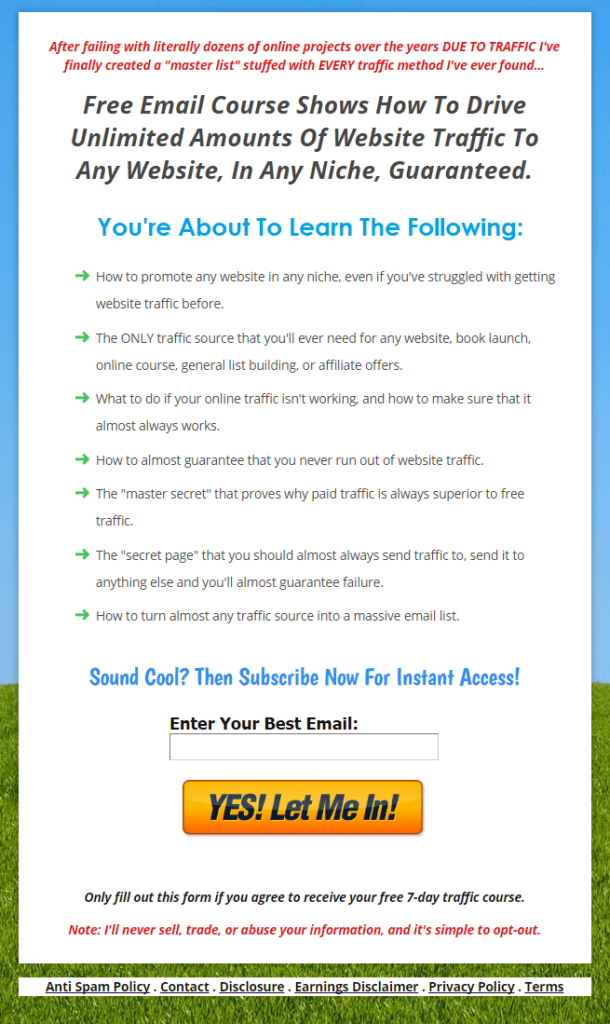
The Perfect Thank You And Confirmation Pages That Thank Your Customer, And Also Sell
Here’s where things get creative.
Don’t use the default email confirmation page that your email autoresponder provides.
Instead, immediately redirect your new subscribers to a custom “confirmation page” that reminds them to CONFIRM their email.
These days, I always recommend everyone use “confirmed opt-in only” – meaning that your students, or any new email leads, must confirm their email address. That way, you’re 100% sure that only legit email subscribers subscribe to your email list.
I think it’s a good idea to make your subscribers confirm their request. Confirmation makes it so you don’t have any malicious activity from a competitor or some troll. Enable double opt-in!
Confirmed opt-in also allows you to promote a confirmation page.
Also, this gives you a perfect chance to thank your new subscriber and also gives you an excellent opportunity to promote a call to action.
So, on your thank you page, you could easily promote whatever offer it is that you want to plug. You can also introduce yourself, share your social media profiles, or advertise anything that you wish.
So maybe your first paragraph thanks your subscriber for subscribing, with a massive headline that tells them to confirm their email.
Under that first paragraph, you could have another headline talking about a discount, or a new offer for your subscriber to click.
Establishing a confirmation page in this way will potentially allow you to make a conversion before your subscriber even confirms their subscription.
Check out a sample confirmation page:
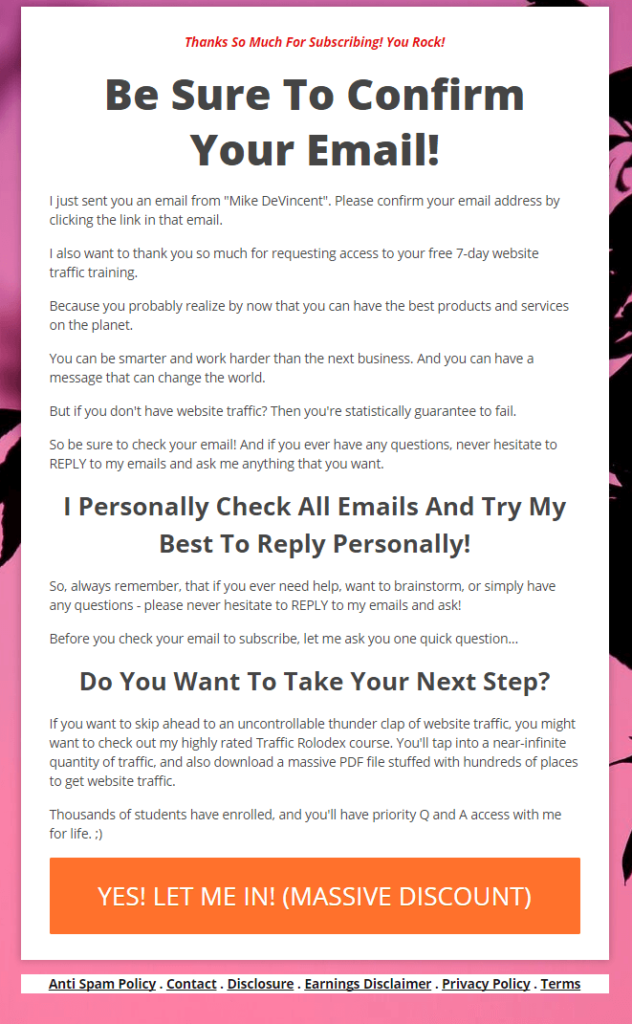
What Happens When A Student Confirms Their Email Course Subscription?
Now, what happens when they check their email and then confirm their subscription?
Two things are going to happen.
First, they’re going to receive email number one of the email course. Twenty-four hours later, they should get email number two, then 24 hours later, they get email number three and so on.
The second thing that happens is that the confirmation page will be a “welcome!” page congratulating the new subscriber for confirming their address.
On that page, you could briefly thank your subscriber, and remind them to check their inbox for the first training email of the 7-day course.
And, you could even go on to promote something on this page again. So, see what we’ve done here? We’ve already invited the subscriber to buy TWO TIMES before they even get their first email.
The best part is that you’re not acting overly aggressive or spammy. You’re generating massive good karma with your audience. You’re about to give your students excellent content for free.
Check out a sample of a cool thank you page:
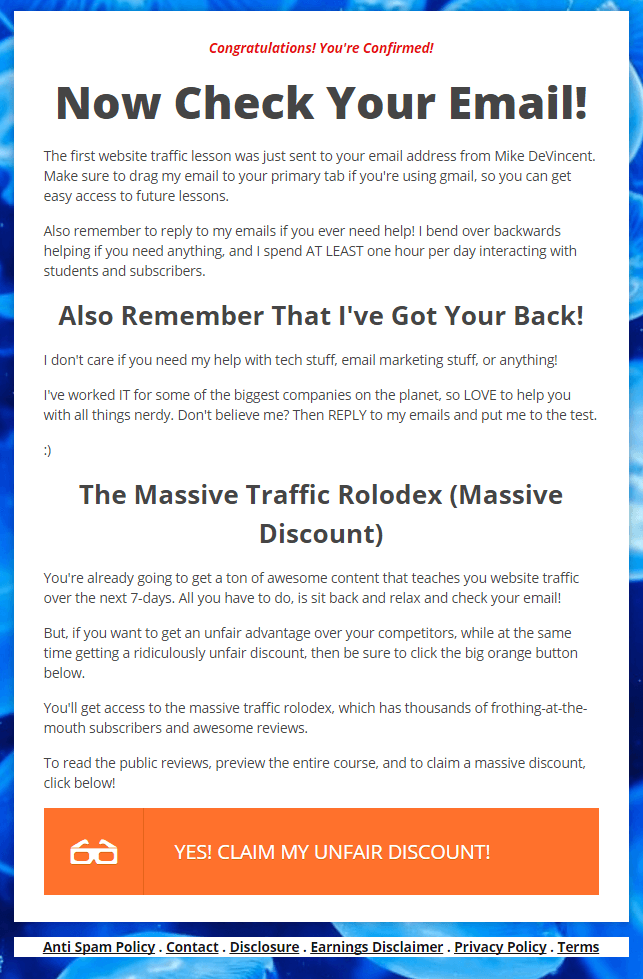
The Easiest And Fastest Way To Deliver Your Email Course Content Automatically
These days, there are so many email autoresponders, and they’re all so advanced.
The following email autoresponders can easily send your email course automatically:
The following companies listed above boast phenomenal automation capabilities.
So you can go as crazy or as simple as you want with this.
Me? I prefer to go old school and relatively low tech. If you’re creating excellent content, simple email automation is all you need.
The main thing to look at is looking at what people are reading and clicking.
As more people join your 7-day course, you’re going to notice trends when viewing your statistics. Your email automation statistics are vitally important!
As you study your email marketing data, you’ll learn a ton about how your email course performs. Maybe some people are reading email number six much more than email number three. This data is precious.
If that’s the case, then you should consider DELETING or moving email number three and replacing it with email number six.
Here’s an example from one of my campaigns:
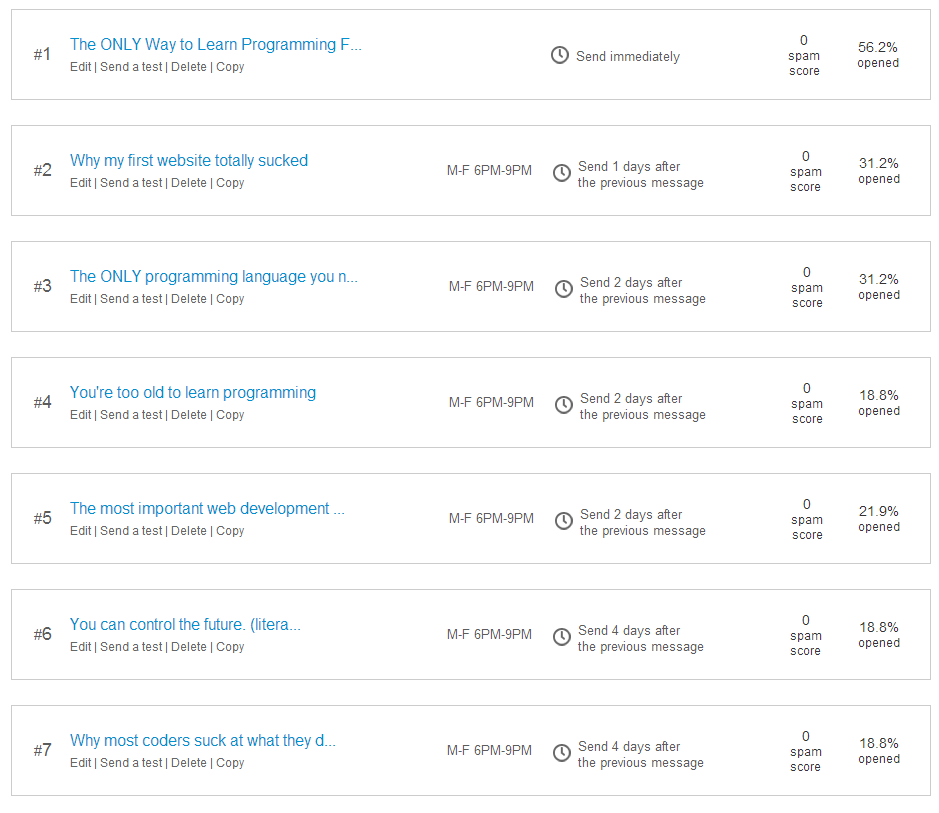
Notice how email number five has a slightly better open rate than the email before it. Wouldn’t it be a smart idea to move email number five closer to the beginning? That way, you can see if maybe you can edit the emails that aren’t doing as good?
The point I’m trying to make here, is to keep a close eye on your statistics. Try to learn what content your students like, and what they don’t like. After a while, it’s possible to find trends, and adjust accordingly.
Also notice, that as your emails progress, your open rate typically reduces. That’s why it’s so important to monitor and check your statistics always.
Having a perfect email course right out of the gate is unlikely. You NEVER know what’s going to work until you have real humans in your email course.
Here’s another exciting campaign:
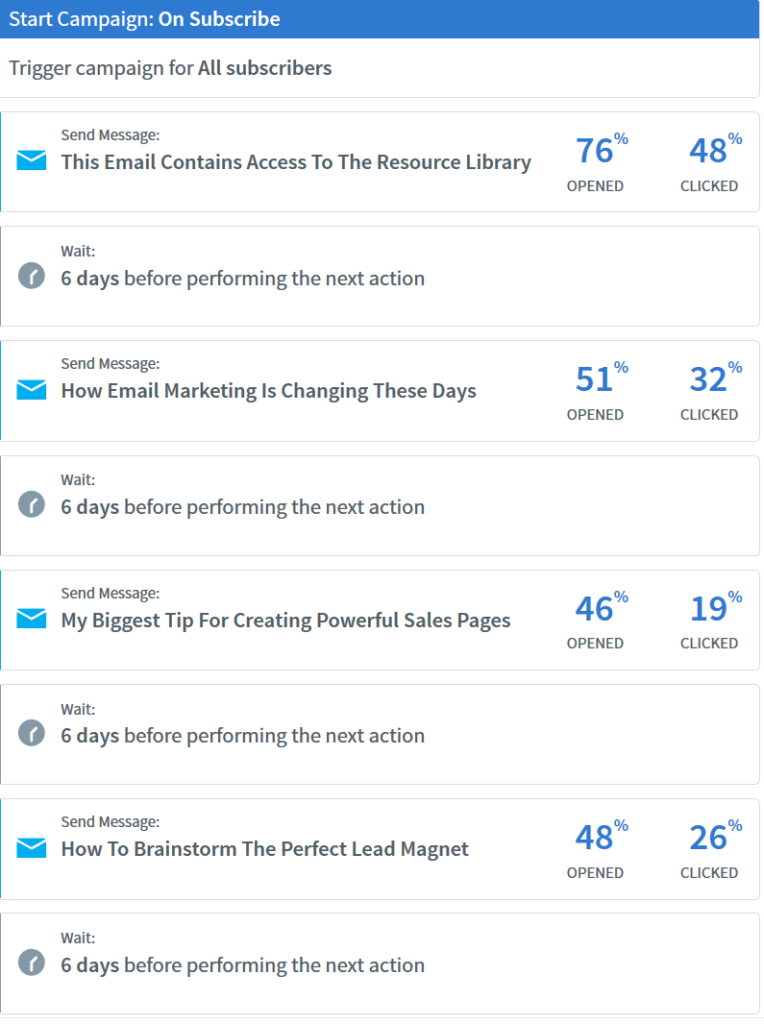
Look how email # four is getting a 48% open rate, but email # three is only getting a 46% open rate. It looks like people LOVE email four, but don’t particularly like email # three as much. The open rates, and clickthrough rates are a little bit better on email # four.
It’s true that the variance isn’t that big here. However, when applicable, I often wonder why emails later in the sequence get better open rates. It’s a fascinating statistic worth considering and analyzing!
Promote Your 7-Day Email Course Everywhere That You Can!
Once you have your 7-day email course all set up, then promoting it is of your top priority.
You have a few choices.
First, try to promote it on social media, in any of your books, or even in your bonus lectures if you’re a Udemy teacher. Plug your 7-day course wherever you publish content online!
You could also use Facebook Ads, Google Ads, or Microsoft Ads to promote your 7-day email course.
If you have a blog, make sure to promote your 7-day email course via a popup and a welcome bar. You can use services like AddThis.com to add non-invasive popups and welcome bars to your sites. Welcome bars rock and they’re a great way to promote anything you want.
Also, create some fresh graphics promoting your 7-day email course. Canva.com is great for creating beautiful graphics for your blog and social media. Make sure that when you write a new blog post, that you have a cool graphic promoting your 7-day course. That way, other people can also share it on Pinterest and other social platforms.
If you have any popular social media channels or any digital assets, then try to leverage those to promote your course. Promote your course anywhere and everywhere!
A Final Email Course Creation Tip!
I hope by now, you realize the power of email courses.
They’re super easy to create, they can help you promote your premium courses, your affiliate links, or your business. All the while, you can build your business, your brand, your email list, and help people.
So, how can you go forward?
Remember that step one is to brainstorm how you can help your audience. Start to break down each email lesson and what content should go therein.
So, what are the seven mini-lessons going to cover? What’s the main topic of your course? What does your audience want to learn?
Also, ask yourself if you have any existing content that you can repurpose right now?
Maybe you think that you have existing content, but it’s not perfect.
Well, remember that you took a vow to not worry about perfectionism. You also learned that the best way to improve any existing email autoresponder is by analyzing and looking at data.
So, never worry if your course isn’t perfect. It’s never going to be accurate, and it’s always a work in progress. It sounds like a lot of work, right? But be happy, because analyzing your email autoresponder statistics will probably be the most fun thing you do all week.
Finally, never forget to sell your stuff!
Remember to sell stuff on your confirmation page, on the thank you page, AND in your email content itself.
Because it’s good to help people, but if you go out of business, how many people are you going to help?
Probably not many.
So add those PS notes in your emails promoting your main offer. Don’t be scared to sell. Love the idea that you’re selling. You know for a fact that your content is helping people, changing lives, and building your own business! All at the same time.
Thank you so much for checking out this guide! If you ever want to brainstorm, never hesitate to give me a buzz.
Cordially yours.
Mike “The Email Course” DeVincent
MrComputerScience.com
